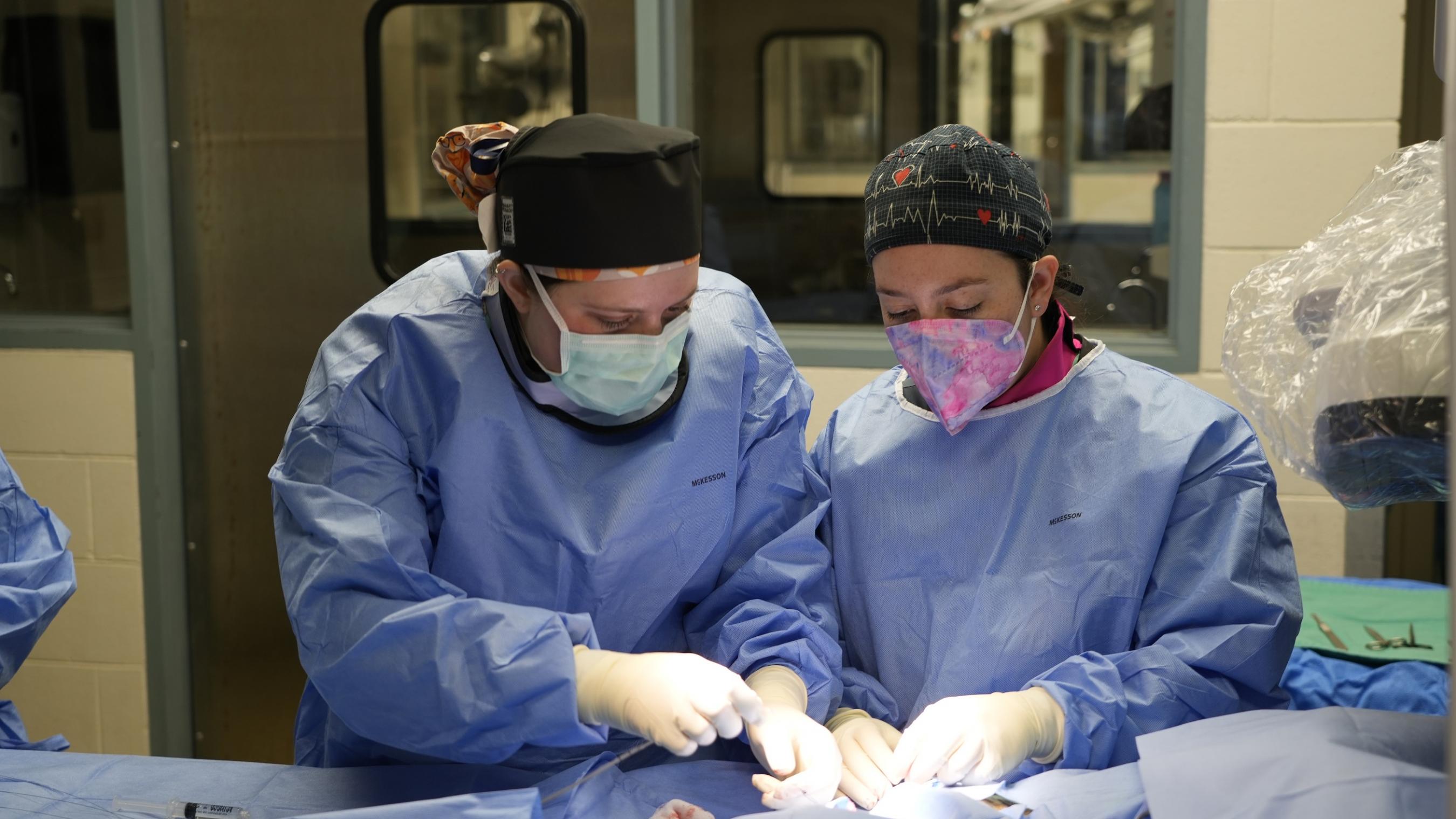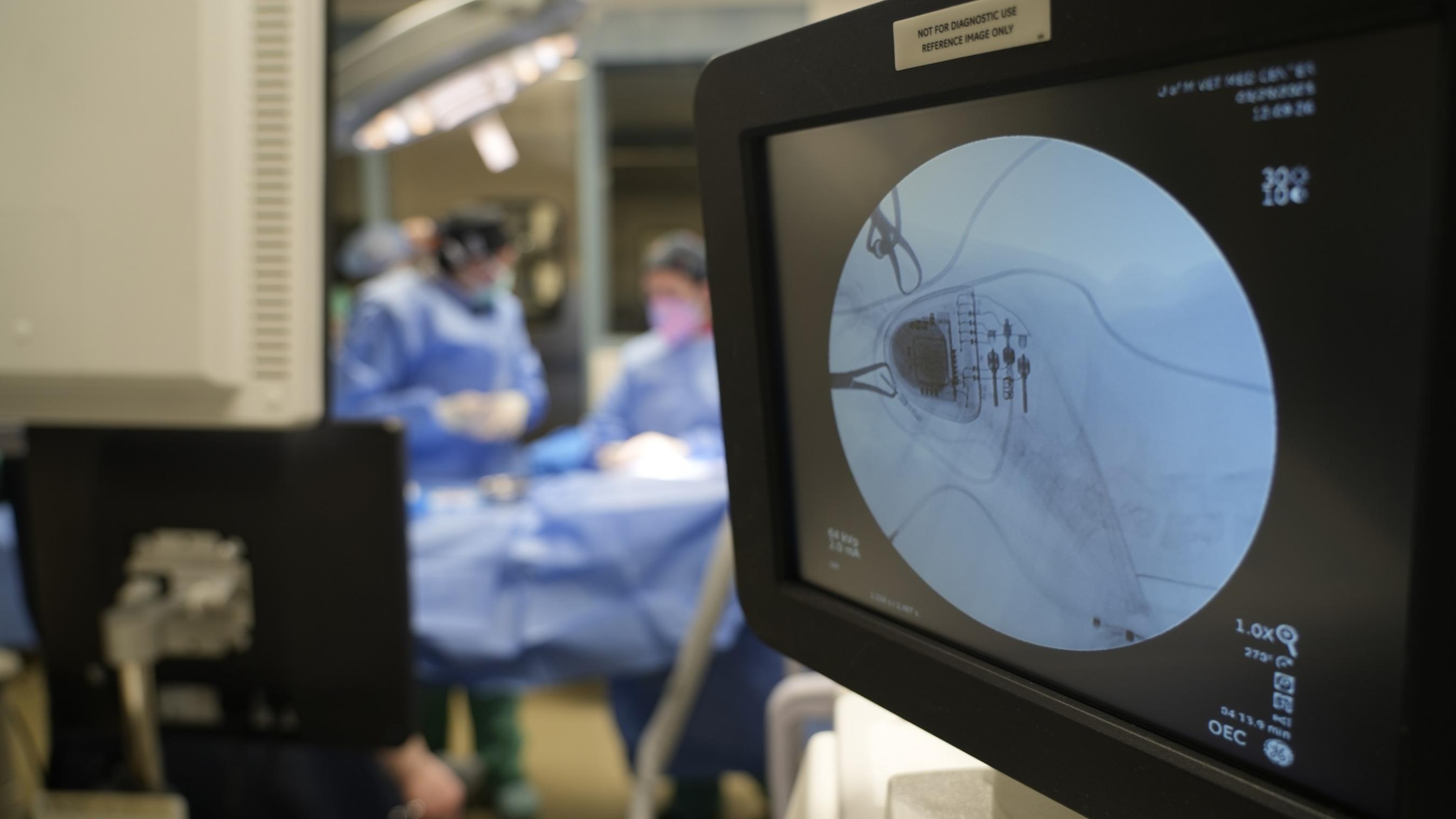Staying on beat
VMC cardiology team places 20 pacemakers a year to save the lives of pets

VMC cardiology team places 20 pacemakers a year to save the lives of pets
Tara, a 12-year-old schnauzer, is one of nearly two dozen dogs that undergo pacemaker implantation surgeries each year at the Veterinary Medical Center.
Richard Berg would watch with dread each time his 12-year-old schnauzer Tara would begin to wobble. Soon after the teetering began, she would faint.
“It was so hard to see,” he says. “I thought for sure I was going to lose her.”
As it turned out, Tara’s heart was the culprit behind the fainting spells. A trip to the veterinarian revealed a diagnosis of sick sinus syndrome (SSS), a disorder that occurs when the heart’s sinus node—the part of the heart that regulates its rhythm—no longer functions properly.
In Tara’s case, her SSS was treated through the implantation of a pacemaker, a medical device that delivers electrical signals to restore a normal heartbeat.
Tara is one of about 20 dogs that receive pacemakers each year at the University of Minnesota Veterinary Medical Center (VMC). It’s a treatment with roots in Minnesota. Electrical engineer Earl E. Bakken invented the first battery-operated, wearable pacemaker in 1957 in Minneapolis. Bakken is the co-founder of Medtronic, which now donates hundreds of pacemakers each year for veterinary procedures through the CanPacers program—including Tara’s. (Read more about Tara’s story here.)
Following Bakken’s breakthrough, the first implantable pacemaker procedure was performed in 1958. Ten years later, the technology was used to treat an abnormal heart rhythm in a dog at the University of Pennsylvania. Since then, pacemaker placement by veterinarians has become more commonplace.
Dr. Christopher Stauthammer, head of the VMC’s Cardiology Service, credits a pacemaker case in veterinary school as part of the inspiration for his pursuit of a cardiology specialty.
“It was Henry, a cocker spaniel who was experiencing passing out symptoms, or syncope, and was eventually diagnosed with atrioventricular heart block,” he recalls. “The dog needed a pacemaker, which was surgically implanted that same day. The passing-out episodes resolved, and Henry was discharged the following day.”
An atrioventricular block occurs when the electrical signal controlling the heartbeat is blocked between the atria and ventricles of the heart. It’s one of a number of conditions in dogs that pacemakers can treat.
Just like humans, some dogs have abnormal heart rhythms—also called arrhythmias. These dogs have a heartbeat that is occasionally too strong or too weak, too slow or too fast, or that skips a beat altogether. While some dogs show few symptoms, others may begin to sleep more, show intolerance to exercise, appear weak or lethargic, collapse or stumble, or, perhaps, vomit and lose their appetite.
A dog’s owner may not pick up on a pet’s symptoms or may attribute changes to the pet’s old age—the arrhythmia remaining undiagnosed. While not all arrhythmias require treatment, others may be life-threatening. Cardiac arrhythmias that do not present clinical symptoms may go undetected altogether until an animal collapses from sudden heart failure or even death.

While the type of heart condition it treats may vary, the implantation of a pacemaker has become a “relatively routine” procedure, according to Stauthammer.
“The process involves a team of anesthesiologists, cardiologists, and amazing veterinary techs, and it takes about two hours to perform after entering the procedure room,” he says.
When inserting a pacemaker, a surgeon makes a small slit in the dog's neck area to implant the device, which generates a signal under the animal’s skin. The device sends that signal through an insulated wire called a lead to conduct the signals from the pacemaker to the heart.
If no complications arise, a dog is able to go home after a day or two and is able to return to regular activities after six weeks.
Most dogs do very well after receiving a pacemaker. The most common complications that occur during or around the time of surgery include failure of the device itself to generate a pulse, displacement of the wire that conducts the signal from the pacemaker to the heart, an infection at the site of the heart where the wire enters or complications arising from anesthesia. The risk of death or a major complication is quite low—generally about 5 percent.

One aspect of Stauthammer’s job that makes it so rewarding is the ability to improve survival times in animals by implanting pacemakers. Survival rates of dogs following the placement of a pacemaker are quite positive. While rates vary depending on factors such as a dog's age, breed, presenting cardiac problem, and experience of the center performing the procedure, most dogs get a good outcome that extends their life and improves the quality of their life.
One published study reports that up to 86 percent of canine patients survive one year after pacemaker implantation, with a 65 percent survival rate at three years post-procedure and 39 percent survival five years after pacemaker placement. Extending a pet’s life by one to more than three years, pacemakers give owners treasured extra time with their beloved pets.
Seeing pets like Tara who received pacemakers during a follow-up visit to the clinic with smiling owners reporting improved energy levels and happier pets makes Stauthammer and the crew who did the implant proud of every success story.
Stauthammer is excited about future improvements in pacemaker technology. One thing on the horizon that he is eager to see incorporated into the technology is the leadless pacemakers. He continues to work with local medical device company Medtronic to improve animal medicine pushing the needle toward better outcomes.